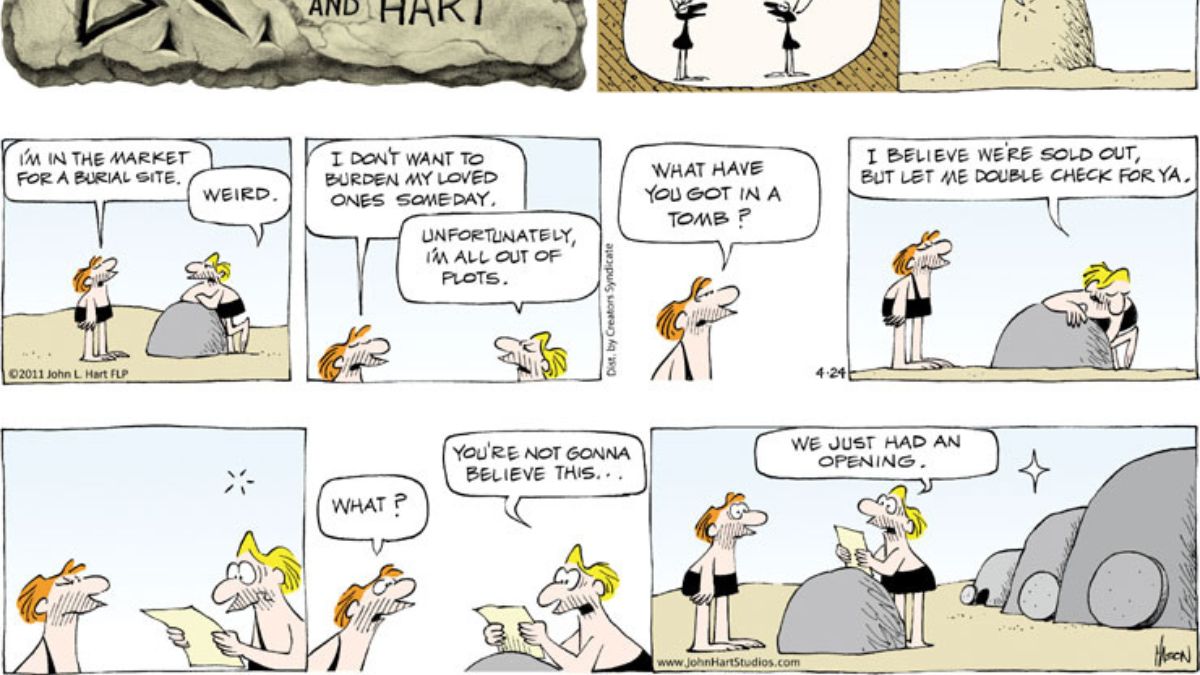

How Johnny Hart Pointed to the Cross and Empty Tomb in the Funny Papers
How the creator of the Wizard of Id and B.C. taught millions about the resurrection of Christ.
03/27/24
John Stonestreet

On Holy Saturday 2007, cartoonist Johnny Hart died of a stroke while working at his drawing table. Hart was the award-winning creator of the popular comic strips The Wizard of Id and B.C. which, at one time, reached 100 million readers worldwide every day. In a 1999 Breakpoint commentary, Chuck Colson identified Hart as “the most widely read Christian of our time,” with “more readers than C.S. Lewis, Frank Peretti, and Billy Graham combined.”
Raised in a moderately religious home, Hart’s faith became more serious around 1984 when a born-again father-son team installed a satellite dish in his home. Not long after that, his Christianity became evident in his comic strips. According to Hart, “It started out like when Christmas would roll around—if a holiday comes up, I do something about the holiday. I’ve been doing that for the life of the strip.” In my view, Hart was always at his best around Easter.
In fact, his most controversial strip was published on Easter of 2001 and featured a Jewish menorah. As the panels progress, the seven candles burn out, each captioned by the seven last words of Jesus from the cross. After the final candle is extinguished, captioned with Jesus’ words, “It is finished,” the arms of the menorah break off and leave a cross. The final panel portrays a trail of blood from the cross to the empty tomb, with the stone rolled away revealing the Lord’s table arranged inside.
At the time, Hart was accused of being antisemitic and of suggesting a form of “replacement theology,” the idea that Christianity supplants Judaism. Hart clarified later that he was only attempting to demonstrate the Jewish roots of Christianity out of respect for both religions. Of course, according to the Gospels, Jesus did claim to complete the requirements of Old Testament law, and according to the author of Hebrews, several Jewish traditions, symbols, and essentials have been fulfilled by Christ.
Another of Hart’s Easter comic strips featured a cross with the note “To Be Continued” attached. In another, one caveman asks a couple of friends, “Would you lay down your life for someone else?”
“That would be pretty stupid,” replies one.
“Yeah, why would we do that?” replies the other.
“You mean, like, would we die in their place … nobody has that much love,” says the first, and the second adds, “And if anyone did, I’d sure hate to lose him!”
Holding a cross, a fourth caveman enters the final scene and says, “Well, guys, I’ve got good news and good news.”
In one of his lighter Easter comics, a caveman tells a salesman “I’m in the market for a burial site. … what have you got in a tomb?” The salesman replies, “I believe we’re sold out but let me double check. … You’re not gonna believe this. … We just had an opening.”
In another, a fruit-juice-stained outfit becomes pure white when rinsed in a river made red by a stream of blood flowing from a cross. And in another, a star casts a cross-shaped shadow across the ground. A caveman explains that could only be possible “if something brighter than the star is behind the star” like “a SUN maybe.” This prompts the other caveman to wonder aloud if it’s perhaps “a SON” making the shadow.
There are many more examples to share, but two have stood out to me since I first read them as a child in the Sunday funny papers of the Washington Post. In one, a caveman says, “I hate the term ‘Good Friday.’ … My Lord was hanged on a tree that day.” Another caveman replies, “If you were going to be hanged on that day, and he volunteered to take your place, how would you feel?”
And the other strip featured Wiley, the grumpy peg-legged caveman, sitting beneath a tree penning the poem “The Suffering Prince”:
Picture yourself tied to a tree, condemned of the sins of eternity.
Then picture a spear parting the air, seeking your heart to end your despair.
Suddenly—a knight in armor of white, stands in the gap betwixt you and its flight,
And shedding his ‘Armor of God’ for you—bears the lance that runs him through.
His heart has been pierced that yours may beat, and the blood of His corpse
washes your feet.
Picture yourself in raiment white, cleansed by the blood of the lifeless knight.
Never to mourn the Prince who was downed, For He is not Lost!
It is you who are found.
Outside of his comic strip, Hart explored and embraced certain theological views I could not agree with. However, he stayed within the bounds of orthodoxy in print and covered an incredible amount of theological ground in the process: from the creation of the world; to the deity of Christ; to the centrality of the cross in history; to the forgiveness of sin and substitutionary atonement. All this in a comic strip.
As Chuck Colson wrote back in 1999, “Johnny Hart can be an inspiration to all of us to find ways to bring a Christian worldview to bear on our work, whatever it may be. Healthy humor is one of God’s good gifts to us, and even writing comic strips can be done to His glory.”
Indeed, every aspect of our redeemed lives can bring glory to God, and that is because of the work of Christ, which for quite a while was described so well over and over again in the Sunday funny papers.
For more resources to live like a Christian in this cultural moment, go to breakpoint.org.
This Breakpoint was originally released on 4.5.23
Have a Follow-up Question?
Up
Next

Related Content

© Copyright 2020, All Rights Reserved.













